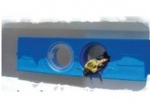 Many farmers worldwide rely on using pesticides and fungicides to protect their crops, which can be harmful and unsustainable. Professor Peter G Kevan, Dr Les Shipp and Professor Vernon G Thomas are exploring the potential of using pollinators as biovectors as a viable alternative. Many farmers worldwide rely on using pesticides and fungicides to protect their crops, which can be harmful and unsustainable. Professor Peter G Kevan, Dr Les Shipp and Professor Vernon G Thomas are exploring the potential of using pollinators as biovectors as a viable alternative.
Can you elucidate the process of bee vectoring?
LS: Bee vectoring, in its simplest terms, is using managed pollinating bees to deliver beneficial microbial agents to flowering plants for the control of insect pests and suppression of plant diseases. These beneficial agents include fungi, bacteria and viruses that target arthropod pests (such as insects and mites) or plant pathogens. The bee picks up the microbial inoculum on its body and hairs, and then spreads the inoculum powder to flowers during the pollination process or whilst self-grooming on plant leaves.
How do you protect the safety of pollinators carrying the biocontrol material?
PK: We have to be sure that the active biocontrol agent does not stress or kill the
pollinators, so we must get the dose and formulation right to accommodate that whilst still suppressing the pest or pathogen incidence.
LS: The safety of the pollinators must be part of the evaluation process when we are
investigating the possibility of an agent being bee vectored. The dispenser is designed so that the bee picks up the inoculum when it leaves the hive, but re-enters through another entrance hole, thus ensuring it does not bring the inoculum into the hive. Furthermore, not every hive requires a dispenser, and the inoculum can be rotated amongst the hives when there is a possibility of an agent having a negative effect.
Is bee vectoring compatible with different types of agriculture, such as organic and
conventional growing?
PK: Yes; the only problem is that, for conventional chemical-based agriculture, more care would have to be exercised with insecticides.
VT:It is compatible with both, but especially organic approaches. Biovectoring can be seen as a vital adjunct to any type of organic agriculture because it does not rely on synthetic control agents or involve energy-intensive spraying; the control agents are all naturally-occurring and ubiquitous materials.
What are the advantages and disadvantages of using vector biocontrol as an alternative
to conventional insecticides and fungicides?
LS: Greenhouse cage and field trials have shown that bee vectoring is as effective as chemical spraying. However, as chemical pesticides work faster than microbial agents (due to the nature of the infection process in the target host), bee vectoring of microbial agents must be applied early. It is also not a curative control measure, and is vulnerable to a number of different variables: weather can have a major impact outdoors (ie. too hot or wet); the bees may not fly; the inoculum can become caked and not remain powdery. Bee vectoring is not a silver bullet and, as such, should be used as part of a more holistic pest management programme.
Could you elucidate your plans to expand pollinator biocontrol vector technology (PBVT) into coffee production?
VT: My main goal is to get biovectoring assessed and, hopefully, deployed widely in coffee production. Trials already indicate that it has the potential to control several fungal diseases of coffee plants, as well as the coffee berry borer. I have a wide interest in several areas but, as a largely retired professor, I will focus on the coffee situation because globally it represents a vast crop that is in need of a new approach.
In what ways does PBVT still need refining?
LS: Like any technology, there will always be constant refining to improve efficiency. We have demonstrated that two fungal biocontrol agents can be combined in the same inoculum for both pest control and disease suppression. There is no reason why other combinations of microbial agents cannot be used.
PK: We need to explore a range of biocontrol agents that could be used against other pests and diseases, and on other crops. We also need to refine the technology so that it can be better used with honey bees.
VT: There is potential to use biovectoring to control viral diseases in crops. Subject to funding, this will be a focus of subsequent research.
|
